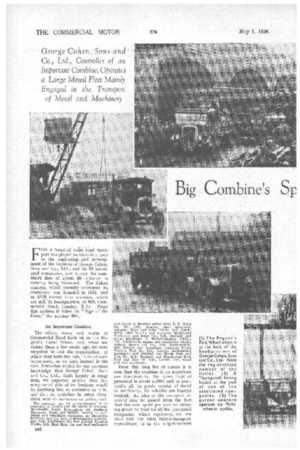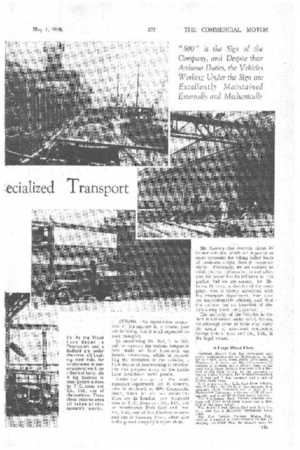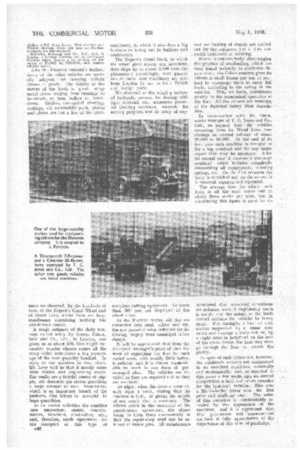Big Combine's Sp ecialized Transport
Page 98

Page 99

Page 100

If you've noticed an error in this article please click here to report it so we can fix it.
FOR a hundred years 'road transport has played an important part In the conducting and development of the business of George Cohen, Sons and Co., Ltd., and its 10 associated companies, and to-day the combine's fleet of about 50 vehicles is steadily being increased. The Cohen concern, which recently celebrated its centenary, was founded in 1834, and in 1876 moved into premises, which are still its headquarters, at 600, Commercial Road, London, E.14. From this address it takes its "Sign of the Firm," the number 600.
An Important Combine.
The offices, stores and works at Commercial Road back on to the Regent's Canal Wharf, and, when we visited these a few weeks ago, we were surprised to find the organization, of which they form the hub, to be of such importance, as we soon learned is the case. Somewhat misled by our previous knowledge that George Cohen, Sons and Co., Ltd., dealt largely in scrap iron, we expected neither that the scrap-metal side of its business would be anything like so extensive as it is, nor' that its activities in other directions were so numerous or widespread.
The company has 14 establishments of its own—five in London and the others in Glasgow. Manchester, Leeds, Birmingham (21, Sheffield, Newcastle, Neath and Bel-last. Among Its associated and subsidiary companies are Batchelor, Robinson and Co,, Ltd., of Binning,ham,LlaneLly, and West Hartlepool; the New London Electron Works, Ltd., East Ham, tin and steal reelatusers and maker of Electron serial 'wire; T. 0. Jones Sod Co., Ltd London, steel structural engineer; Kryn and Lahy (1928), Ltd., Letchworth, steel founder and engineer; Motherwell Machinery and Scrap Co., Ltd., engineer and metal merchant; J. Browett-Lindley (1931), ltd., Letchworth, engine and compressor maker; Pollock. Brawn and Co., Ltd, Southampton, ship breaker and demolition engineer; Belson Machine Tool Co., Ltd., London, machine-tool merchant; and Southall and Mayes Coal and Iron Co., Ltd., Sonthall, and 1:4e'rbonrae Park Coal and Iron Co. Ltd., London, iron, metal and coal merchants.
From this long list of names it is seen that the combine is an important one (incidentally, the gross total of personnel is about 4,000) and as practically all its goods consist of metal or machinery, its vehicles are heavily worked. An idea of the transport involved may be gained from the fact that the sum spent per year on carrying goods by road for all the associated companies, which represents far less than half the total inland-transport expenditure, is in the neighbourhood
of £100,000. An appreciable propor.tion of this amount is, of course, paid out in hiring, but it is all expended on road transport.
In -considering thefl fleet; it is diffi. cult to separate the, various companies into units as their businesses are largely interwoven, whilst in , controlling the operation of the vehicles, a high degree of interworking is effected. For this purpose many of the lorries have detachable name panels'.
Under the manager of the road transport department, Mr. R. Gomm°, who is stationed at COO, Commercial Road, where he has two assistants ; there are its London two transport men at T. C. Jones and Co., Ltd., one at' Westbourne Park Coal and Iron Co., Ltd.; one at the Electron ccncern and one at Canning Town, where also ia the parent company's repair shop.
Mr. Comme also controls about horsed vehicles, Which are regarded, as more economic for taking bulky loads of moderate weight through congested traffic. Personally, we are inclined to think that an old association and affection-for horses has its influence -in this matter, but we are assured by Mr, Lewis 0: Levy, a' director of the company, who is closely associated with the transport department, that they are unquestionably efficient„ and that -the concern has no intention-of dis continuing " their ernployment::.... The majority Of the vehicles in the 'fleet .is authorized Under one C licence. for although. some of them may carry The names of as.sociatecl comPanies, Oeorge Cohen, Sons and Co., Ltd., is the legal owner.
A Large Mixed Fleet.
Operated directly from the Last-named concern's headquarters are six Multiwheoler ontftts for maximum loads,, three ialley 7-8-tonners, Thornycroft 5-tonner, two Morris-Commercial 3. Loaners', a 2-tonner and a 30-cwt. lorry oi the same make, three Fordson 2-tanners and a Bedford or the same rating. In theprovinces it runs a Bailey 3-tonner, two Moms-Commercials of 3 tons and 2 tans capacity and a pair of Morris 5-ewt. vans. c. Jones and Co., Ltd, runs three Albions, two of 3 tons and one of tons capacity, four Bedfords, three 2-tonners and a 3-tunnel.' a Thornycroft 7.8-tonner, a Commer of 30-40 cwt. ca_pacity and a couple of Ford 5-cwt. vehicles. The Westbourne Park concern operates two Scacamell 3-ten, mechanical horses and a Bedford of the same rating.
• The Southall and Hayes Coal and Iron Co., Ltd., also has a Scammell mechanical horse
outfit. . The, Now London Electron Works, Ltd., operates a number of large-capacity trailers for carrying uncrushed tins, the tractive units in
eluding A.D.C. 6-ton lorries, Moltiwbeelers and Pordson tractors. Frem this base two Fordson 2-formers are also operated.
Batchelor, Robinson and Co., Ltd., uses. in London, a Fordson 2-tonner and an old Garner 5-tonner -which despite a big mileage on the re re nle°0 to. 1004000), St n renders efficient Like the Electron concern's trailers, many of the other vehicles are specially adapted • for carrying certain classes of goods. The variety of the nature of the loads is great, scrap metal alone ranging from turnings to bedsteads, or from boilers to horseshoes. • Girders, corrugated sheeting, castings, old automobile parts, piping and plates are but a few of the speci
mans we observed, by the hundreds of tons, at the Regent's Canal Wharf and at Wood Lane, whilst there are large storehouses containing nothing but non-ferrous metals.
A rough estimate of the daily tonnage carted solely by George Cohen, Sons and Co., Ltd., in London, was given us as about 500. One might excusably wonder whence comes all the scrap which constitutes a big percentage of the vast quantity handled. In reply to our question to that effect, Mr. Levy told us that it mostly came from dealers and engineering shops. Gas works are a fruitful source of supply, old domestic gas stoves providing a large amount of iron. Demolition, which is an important branch of the business, also brings in material in huge quantities.
In its varied activities the combine uses excavators, cranes, concrete mixers, -trenchers, road-rollers, etc., and, therefore, needs equipment for the transport of this type of
c42 machinery, in which it also does a big business in hiring out to builders and contractors.
The Regent's Canal Dock, to which the wharf gives access, can accommodate ships up to about 2,500 tons displacement ; accordingly, vast quantities of metal and machinery are sent from London by sea to both British and foreign ports.
We observed at the wharf a battery of hydraulic presses, for dealing with light material, etc., numerous powerful shearing machines, magnets for sorting purposes and an array of oxy
acetylene cutting equipment. No fewer than 200 men are employed at the wharf alone.
At the Electron works, old tins are converted into steel, solder and tin, the raw material being collected for detinning, Largely from municipal refuse dumps.
It will be appreciated that from the transport manager's point of view the work of organizing the fleet for such varied work, with usually little notice, is arduous, and it is almost impaactkable to work to any form of prearranged plan. The vehicles are detailed as they are required and as they are available.
At night, when the drivers come in, each signs a book, stating that his machine is O.K., or giving the details of any repair that is necessary. The drivers assist in the execution of the maintenance operations, the object being to train them mechanically so that the repair-shop staff can be relieved of minor jobs. All maintenance and overhauling of chassis are carried out by the company, but it does not tackle bodywork or painting.
Whilst whole-heartedly discouraging the practice of overloading, which has been found seriously to accelerate depreciation, the Cohen concern gives its drivers a small bonus per ton of payload to encourage them to carry full loads, according to the rating of the vehicles. This, we /earn, contributes greatly to the economical operation of the fleet. All the driverS are member: of the National Satety First Association.
In conversation with Mr. Stern, works manager of T. C. Jones and Co., Ltd., we learned that the vehicles operating from its Wood Lane base average an annual mileage of about 20,000 to 25,000. At the end of its first year each machine is brought in for a top overhaul and for any major repair that may be necessary. After its second year it receives a thorough overhaul, which includes completely dismantling all components, resettipg springs, etc. On the first occasion the body is varnished and on the second it is removed, repaired and repainted.
The average time for which each lcrry is off the road works out at about three weeks per year, but in considering this figure it must be re membered that operating conditions are arduous, work in engineering yards is rough, and the nature of the loads carried subjects the vehicles to heavy usage. For example, a load of steel girders suspended by a crane may swing and damage a body side or, by a slight error in judgment on the part of the crane driver, the load may even go through the floor or smash the gantry.
In spite of such difficulties, however, the combine's vehicles are maintained in an excellent condition, externally and mechanically, and, as reported in this paper a few weeks ago, an annual competition is held and prizes awarded for the best-kept vehicles. This year a Multiwheeler driver won the first prize and challenge cup. The value of this incentive is unmistakably rewaled by the appearance of the machines, and it is significant that this prosperous and consequential combine is fully appreciative of the importance of this form of publicity:








































































































































































